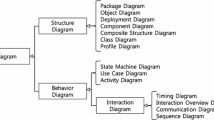Abstract
The Unified Modeling Langugage (UML) offers different diagram types to model the behavior of software systems. In some domains like embedded real-time systems or multimedia systems, it is necessary to include specifications of time in behavioral models since the correctness of these applications depends on the fulfillment of temporal requirements in addition to functional requirements. UML thus already incorporates language features to model time and temporal constraints. Such model elements must have an equivalent in the semantic domain.
We have proposed Dynamic Meta Modeling (DMM), an approach based on graph transformation, as a means for specifying operational semantics of dynamic UML diagrams. In this article, we extend this approach to also account for time by extending the semantic domain to timed graph transformation. This enables us to define the operational semantics of UML diagrams with time specifications. As an example, we provide semantics for special sequence diagrams from the domain of multimedia application modeling.
Similar content being viewed by others
References
David A, Möller MO, Yi W (2002) Formal verification of UML statecharts with real-time extensions. In: Proc. 5th International Conference on Fundamental Approaches to Software Engineering (FASE 2002), Lecture Notes in Computer Science, vol 2306. http://www.springer.de/comp/lncs. Springer, pp 218–232
Engels G, Hausmann JH, Heckel R, Sauer S (2000) Dynamic Meta Modeling: A graphical approach to the operational semantics of behavioral diagrams in UML. In: Evans A, Kent S, Selic B (eds) Proc. UML 2000, York, UK, Lecture Notes in Computer Science, vol 1939. http://www.springer.de/comp/lncs. Springer-Verlag, pp 323–337
Ehrig H, Pfender M, Schneider HJ (1973) Graph grammars: An algebraic approach. In: 14th Annual IEEE Symposium on Switching and Automata Theory. IEEE, pp 167–180
Engels G, Sauer S (2002) Object-oriented modeling of multimedia applications. In: Chang SK (ed) Handbook of Software Engineering and Knowledge Engineering, vol 2. World Scientific, Singapore, pp 21–52
Firley T, Huhn M, Diethers K, Gehrke T, Goltz U (1999) Timed sequence diagrams and tool-based analysis – A case study. In: France R, Rumpe B (eds) Proc. UML ’99, Lecture Notes in Computer Science, vol 1723. Springer-Verlag, pp 645–660
Gyapay S, Heckel R, Varro D (2002) Graph transformation with time: Causality and logical clocks. In: Corradini A, Ehrig H, Kreowski H-J, Rozenberg G (eds) Proc. 1st International Conference on Graph Transformation (ICGT 02), Barcelona, Spain, Lecture Notes in Computer Science, vol 2505. Springer-Verlag, pp 120–134
Gyapay S, Heckel R, Varro D (2003) Graph transformation with time In: Fundamenta Informaticae 58(1):1–22
Ghezzi C, Mandrioli D, Morasca, Pezzè, S (1991) A unified high-level Petri net formalism for time-critical systems. IEEE Transactions on Software Engineering 17(2):160–172
Hausmann JH, Heckel R, Sauer S (2001) Towards dynamic meta modeling of UML extensions: An extensible semantics for UML sequence diagrams. In: Proc. IEEE Symposia on Human-Centric Computing Languages and Environments (HCC’01), pp 80–87
Hausmann JH, Heckel R, Sauer S (2002) Dynamic Meta Modeling with time: Specifying the semantics of multimedia sequence diagrams. In: Bottoni P, Minas M (eds) Proc. International Workshop on Graph Transformation and Visual Modeling Techniques (GTVMT 2002), Barcelona, Spain, Electronic Notes in Theoretical Computer Science 72(3). http://www.elsevier.nl/locate/entcs. Elsevier Science
Heckel R, Wagner A (1995) Ensuring consistency of conditional graph grammars – A constructive approach. In: Proc. of SEGRAGRA’95 “Graph Rewriting and Computation”, Electronic Notes in Theoretical Computer Science, vol 2. http://www.elsevier.nl/locate/entcs. Elsevier Science
Kreowski H-J (1977) Manipulation von Graphmanipulationen. PhD thesis, Technical University of Berlin, Department of Computer Science
Küster JM, Stroop J (2001) Consistent design of embedded real-time systems with UML-RT. In: Proc. IEEE Symposium on Object-Oriented Real-Time Distributed Computing (ISORC 2001), pp 31–40
Li X, Lilius J (1999) Timing analysis of UML sequence diagrams. In: France R, Rumpe B (eds) Proc. UML ’99, Lecture Notes in Computer Science 1723. Springer, pp 661–674
Guldstrand Larsen K, Pettersson P, Yi W (1997) UPPAAL in a nutshell. International Journal on Software Tools for Technology Transfer 1(1–2):134–152
Mühlhäuser M, Gecsei J (1996) Services, frameworks, paradigms for distributed multimedia applications. IEEE Multimedia 3(3):48–61
Object Management Group (2002) UML Profile for Schedulability, Performance, and Time, OMG adopted specification
Object Management Group (2003) OMG Unified Modeling Language Specification, version 1.5
Petriu DC, Shen H (2002) Applying the UML performance profile: Graph grammar-based derivation of LQN models from UML specifications. In: Computer Performance Evaluation, Modelling Techniques and Tools (Proceedings of TOOLS 2002), Lecture Notes in Computer Science, vol 2324. Springer-Verlag, pp 159–177
Sauer S, Engels G (2001) UML-based behavior specification of interactive multimedia applications. In: Proc. IEEE Symposia on Human-Centric Computing Languages and Environments (HCC’01), pp 248–255
Schürr A, Winter AJ, Zündorf A (1997) PROGRES: Language and environment. In: Ehrig H, Engels G, Kreowski H-J, Rozenberg G (eds) Handbook on Graph Grammars and Computing by Graph Transformation: Applications, Languages, and Tools. World Scientific, Singapore, pp 487–550
Taentzer G (1999) AGG: A tool environment for algebraic graph transformation. In: Proc. International Workshop on Applications of Graph Transformations with Industrial Relevance (AGTIVE 1999), pp 481–488
Author information
Authors and Affiliations
Corresponding author
Rights and permissions
About this article
Cite this article
Hausmann, J., Heckel, R. & Sauer, S. Dynamic Meta Modeling with time: Specifying the semantics of multimedia sequence diagrams. Softw Syst Model 3, 181–193 (2004). https://doi.org/10.1007/s10270-003-0045-7
Received:
Accepted:
Published:
Issue Date:
DOI: https://doi.org/10.1007/s10270-003-0045-7




